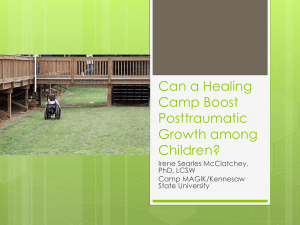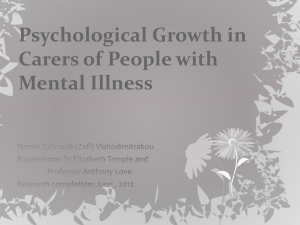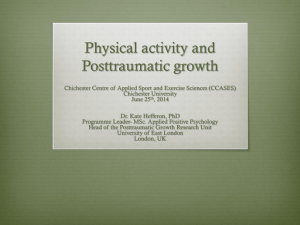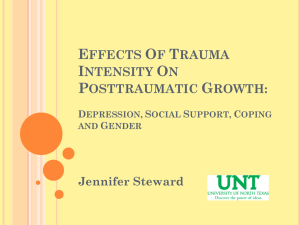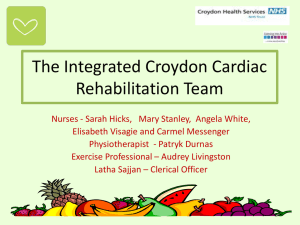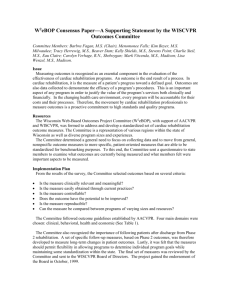View/Open - YorkSpace
advertisement
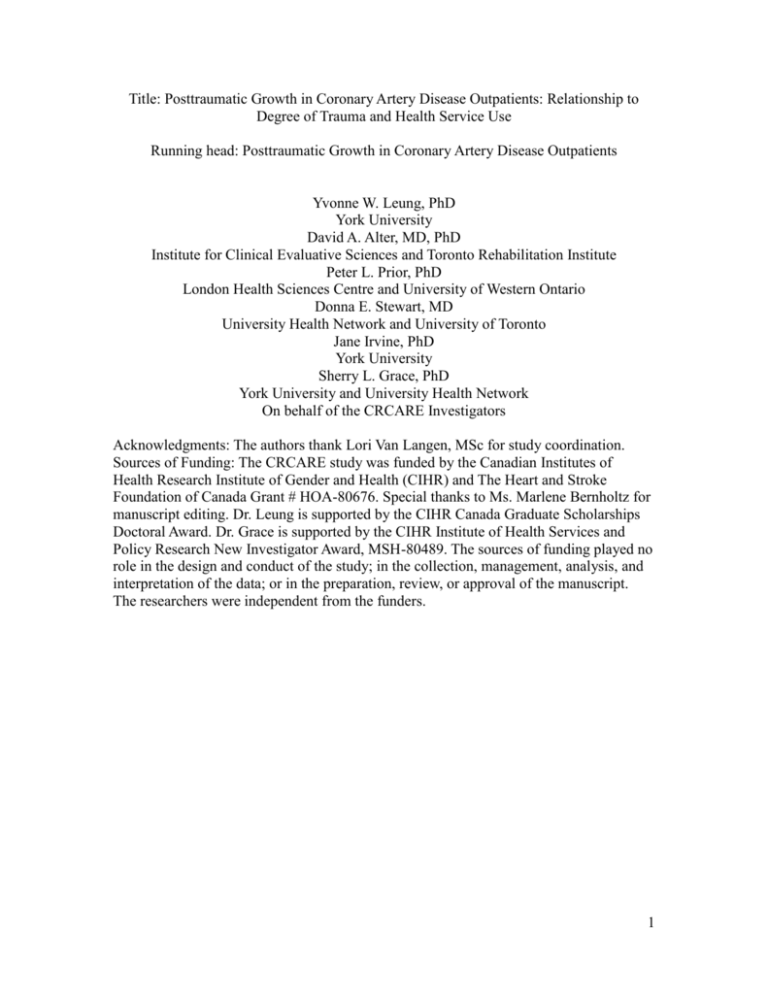
Title: Posttraumatic Growth in Coronary Artery Disease Outpatients: Relationship to Degree of Trauma and Health Service Use Running head: Posttraumatic Growth in Coronary Artery Disease Outpatients Yvonne W. Leung, PhD York University David A. Alter, MD, PhD Institute for Clinical Evaluative Sciences and Toronto Rehabilitation Institute Peter L. Prior, PhD London Health Sciences Centre and University of Western Ontario Donna E. Stewart, MD University Health Network and University of Toronto Jane Irvine, PhD York University Sherry L. Grace, PhD York University and University Health Network On behalf of the CRCARE Investigators Acknowledgments: The authors thank Lori Van Langen, MSc for study coordination. Sources of Funding: The CRCARE study was funded by the Canadian Institutes of Health Research Institute of Gender and Health (CIHR) and The Heart and Stroke Foundation of Canada Grant # HOA-80676. Special thanks to Ms. Marlene Bernholtz for manuscript editing. Dr. Leung is supported by the CIHR Canada Graduate Scholarships Doctoral Award. Dr. Grace is supported by the CIHR Institute of Health Services and Policy Research New Investigator Award, MSH-80489. The sources of funding played no role in the design and conduct of the study; in the collection, management, analysis, and interpretation of the data; or in the preparation, review, or approval of the manuscript. The researchers were independent from the funders. 1 Abstract Objectives Posttraumatic growth (PTG) is frequently reported after the strike of a serious medical illness. The current study sought to: 1) assess the relationship between degree of cardiac “threat” and PTG one year post-hospitalization; and 2) to explore the association between PTG and healthcare utilization. Methods In a cohort study, 2636 cardiac inpatients from 11 Ontario hospitals completed a sociodemographic survey,; clinical data were extracted from charts. One year later, 1717 of these outpatients completed a postal survey, which assessed PTG and healthcare utilization. Morbidity data were obtained retrospectively through probabilistic linkage to administrative data. The predicted risk of recurrent events for each participant was calculated using a logistic regression model, based on participants’ sociodemographic and clinical characteristics. The relationship among PTG, trauma and health service use was examined with multiple regression models. Results Greater PTG was significantly related to greater predicted risk of recurrent events (p<.001), but not the actual rate of recurrent events (p=.117). Moreover, greater PTG was significantly related to more physician visits (p=.006), and cardiac rehabilitation program enrolment (p=.001) after accounting for predicted risk and sociodemographic variables. PTG was not related to urgent healthcare use. Conclusions Greater PTG was related to greater objective risk of morbidity but not actual morbidity, suggesting that contemplation about the risk of future health problems may spur PTG. Moreover, greater PTG was associated with seeking non-urgent healthcare. Whether this translates to improved health outcomes warrants future study. Word count: 248 Key words: Posttraumatic growth, coronary artery disease, benefit finding, clinical risk, health service use 2 Introduction Coronary artery disease is one of the leading causes of mortality and morbidity worldwide [1]. Given the chronic nature of this disease, it is important to understand a patient’s psychological response and adaptation to living with a cardiac condition. For instance, up to 20% of recently-diagnosed cardiac patients report elevated symptoms of depression [2], and 50% report anxiety [3]. This is disconcerting given that symptoms of depression double the risk of cardiac mortality [4]. However, some emerging evidence has demonstrated that struggling with lifethreatening adversity can be a catalyst for personal growth and transformation. For example, research has found that patients may change the way they view themselves, their priorities, and their interactions with others in response to a health-related trauma [5-8]. Posttraumatic growth (PTG) is defined as the experience of positive consequences arising from the struggle with a traumatic experience, where the resulting transformation leads not only to a return to previous levels of well-being (such as with thriving, benefitfinding or resilience), but to a higher level of functioning in some aspects of life [6,9]. PTG has been associated with reduced mortality among cancer patients [10] and Human Immunodeficiency Virus/ Acquired Immune Deficiency Syndrome (HIV/AIDS) patients [11] and morbidity among cardiac patients [5]. In particular, Affleck et al. (1987) showed that male myocardial infarction patients who experienced such positive psychology in the weeks after their cardiac event were less likely to have another infarction and experienced less morbidity eight years later [12]. To experience PTG, an individual must be significantly threatened by a traumatic 3 event [6]. The emotional distress compels the individual to re-evaluate and reformulate his or her world view to make sense of the traumatic experience [13]. Some of the previous research on PTG conducted among cancer patients has shown a mixed relationship between PTG and the degree of threat experienced [14,15]. For instance, a meta-analysis conducted by Helgeson et al. (2006) examined both the objective and subjective severity of threat (i.e., physician rating of disease severity vs. person’s report of amount of stress experienced), and concluded that both measures of threat were positively associated with PTG. Yet, a systematic review of the cancer literature by Stanton (2006) [14] concluded that PTG was positively related to subjective threat but showed no relationship to objective illness severity, as indicated by tumor size [16] and extent of metastasis [17]. In the cardiac literature, only three studies [16,18,19] have explored the relationship between psychological change and the severity of cardiac trauma, and have found mainly null relationships. However, these studies were limited by small sample size, the inclusion of only myocardial infarction patients, and the use of qualitative methods of PTG assessment. PTG and Health Service Use PTG is shown to relate consistently to adaptive coping strategies [20] and positive health behaviours [12,21,22], which may explain its association with positive outcomes. Indeed, a qualitative study of female cardiac patients revealed ‘Getting Health Care’ as one of the four themes which emerged from the open-ended question of whether participants experienced positive effects post-myocardial infarction [19]. For example, proactive visits to primary care physicians for secondary prevention has been linked to reduced 4 hospitalization rates [23]. Yet there has been no quantitative study on the relationship between PTG and health service use, including cardiac rehabilitation. The objectives of this study were first to assess the relationship between PTG one year post-hospitalization and trauma, namely objective indicators of (a) rehospitalization due to Major Adverse Cardiac Events (MACEs) over one year post-hospitalization, and (b) the predicted risk of MACEs one-year post-hospitalization.. Second, the current study aimed to assess the relationship between PTG and health service use over one year posthospitalization, namely (a) urgent healthcare use, such as emergency room and hospital admissions, and (b) non-urgent health care use such as visits to physicians and enrolment in cardiac rehabilitation among cardiac outpatients. Methods Design and Procedure The current study was undertaken within a prospective cohort study titled ‘Cardiac Rehabilitation care Continuity through Automatic Referral Evaluation’ (CRCARE; [24]). This study was approved by the Research Ethics Boards of all participating institutions. Thus, this is a secondary analysis and the sample size was powered in accord with the objectives of the larger study. The design is cross-sectional. Medically stable cardiac inpatients from 11 community and academic hospitals in Canada were approached to participate. Upon providing informed consent, eligible inpatients completed a survey assessing their sociodemographic characteristics. Clinical data were extracted from medical charts. Participants were then mailed a follow-up survey one year later, assessing self-reported PTG and health service use. Participants also consented to linkage of their responses to administrative databases to 5 ascertain their medical trajectory. Rehospitalization due to MACEs during the over year follow-up period was examined retrospectively. This was achieved at the Institute of Clinical Evaluative Science through probabilistic, anonymized linkage to physician claims in the Canadian Institute for Health Information database. Participants A total of 2636 stable cardiac inpatients were recruited. Inclusion criteria of the larger study were: confirmed acute coronary syndrome diagnosis, patients who had undergone percutaneous coronary intervention or coronary artery bypass graft surgery, or patients with a concomitant diagnosis of heart failure or arrhythmia. In addition, patients had to meet the eligibility requirements for cardiac rehabilitation based on guidelines of the Canadian Association of Cardiac Rehabilitation [25], and have sufficient language proficiency in English, French, or Punjabi (surveys were translated into each of these languages). Diagnosis of acute coronary syndrome was confirmed through patient chart indication of detailed history, focused physical examination, diagnostic electrocardiogram changes, and/or troponin levels above the 99th percentile of normal. Patients were excluded if they had participated in cardiac rehabilitation within the past 2 years, or had a significant orthopedic, neuromuscular, visual, cognitive or non-dysphoric psychiatric condition (i.e., schizophrenia) that precluded cardiac rehabilitation participation. Measures Independent variable The Posttraumatic Growth Inventory (PTGI) [26] is an instrument for assessing positive outcomes reported by persons who have experienced traumatic events. The PTGI is a 21-item measure with five subscales: New Possibilities, Relating to Others, Personal 6 Strength, Appreciation of Life, and Spiritual Change [26]. It was administrated in the 12month post-hospitalization survey. Participants were instructed to indicate on a 6-point Likert scale (0=no change to 5=very great degree) if a life change (e.g., ‘I can better appreciate each day’) had occurred as a result of their cardiac condition. The PTGI total score was computed by summing all item responses, and thus ranged from 0-105. Tedeschi and Calhoun (1996) reported the internal consistency coefficient of the PTGI to be .90. The PTGI scale has well-established levels of reliability and validity in response to a variety of traumatic events, including coronary artery disease [20,27]. The Cronbach’s alpha of the PTGI total score in the current sample was .91. Sociodemographic Characteristics of Participants The sociodemographic variables assessed through the in-hospital self-report survey included education level, work status, marital status, family income and ethnocultural background. These were assessed through forced-choice response options. The latter included a list of 12 ethnocultural backgrounds (including ‘other’ and ‘multiple’) as adapted from Statistics Canada (www.statcan.ca). Age and sex were extracted from the outpatient medical charts. Table 1 demonstrates the categorization of each variable. Clinical Characteristics of Participants The clinical variables such as nature of cardiac condition / procedure were assessed via the inpatient medical chart. Other variables including disease severity, smoking status, previous cardiac event, family history of cardiac event, comorbidities, and body mass index were assessed through the patients’ in-hospital survey. Disease severity was assessed by the Duke Activity Status Index [28], which is a widely-used 7 psychometrically-validated scale to measure functional status in cardiac samples [29], while all others were assessed via investigator-generated items. Objective Trauma Indicators In this study, two indicators of objective cardiac trauma were used. The first indicator was defined as rehospitalization due to specific MACEs: myocardial infarction, heart failure, or stroke. This was assessed retrospectively. These data were obtained through hospital and physician claims in the administrative databases. Second, the probability of having MACEs was calculated based on all available sociodemographic and clinical variables to assess clinical risk for each participant. Urgent and Non-Urgent Health Service Use Participants’ health services use during the one-year post-hospitalization period was assessed in the one-year post-hospitalization survey. The types of health services assessed included both urgent and non-urgent healthcare. Urgent healthcare included emergency room and hospital admissions for cardiac problems. Non-urgent healthcare included the number of visits to the primary care physician and cardiologist, and enrolment in cardiac rehabilitation. In the one-year follow-up survey, participants were asked to indicate how many times they used each type of health service and whether they were enrolled in a cardiac rehabilitation program during the past year. Statistical Analyses All analyses were conducted with SAS 9.2 [30]. Descriptive statistics were performed. Chi-square, Pearson’s r, and t-tests were used to test for significant relationships between PTG and participant characteristics, trauma indicators, and health service use, as appropriate. A correlation matrix using Pearson’s r was performed to 8 examine associations among PTG and the dependent variables. Predicted Risk of MACEs One Year Post-hospitalization In order to calculate predicted risk of MACEs for each participant based on their characteristics, missing data were first handled. Variables for which more than 5% of values were missing were subjected to multiple imputation by using PROC MI and PROC MIANALYZE in SAS 9.2 [30, 31,]. Data were imputed using the Markov Chain Monte Carlo algorithm. PROC MI by default imputed five completed data sets, which were analyzed by the logistic regression model to yield five sets of parameter estimates. The regression equation was used to model the odds of re-hospitalization due to MACEs within the one-year post-hospitalization period, based on all available clinical and sociodemographic characteristics of the participants. Next, these parameter estimates were combined using PROC MIANALYZE, resulting in corrected statistical influences, which were then used in the imputed data sets to compute a predicted risk score for each participant. An average of five predicted risk scores was generated for each participant. Since the predicted risk of MACEs is a product of a multiple regression model, the Person’s r test was used to correlate PTG against the predicted risk of MACEs as per objective 1. The analytic approach for the other indicators in objective 1 is outlined below. Objective 1: The Relationship between PTG and Cardiac Trauma In addition to testing one of the two objective indicators by the means reported above, the Student t-test was used to compare the PTGI total score based on whether the participant experienced any MACEs (yes/no). Then, the rate of MACEs by PTG was also analyzed via survival analysis. To achieve this, first, time-to-event was measured from 9 the date of index hospitalization to the date of a MACE within a one-year posthospitalization timeframe. Kaplan-Meier analysis was then used to estimate rehospitalization rates during the one-year post-hospitalization period by tertiles of the PTGI total score. The Wilcoxon-Gehan test was used to compare the survival curves by tertiles. Objective 2: PTG in Relation to Urgent and non-Urgent Health Service Use over One-year Post-hospitalization The relationship between use of each type of health service and the PTGI total score were examined using Pearson’s r or Student t-test as appropriate. The number of visits to the general practitioner and cardiologist was treated as a continuous variable due to the wide range of responses (i.e., 0 to 60 visits per year). The number of visits to emergency room and rehospitalization due to heart problems were dichotomized (Yes vs. No). If the relationship was significant, a multiple regression model was performed to further examine their relationship with PTGI total score with adjustment for potential confounding variables. The same method of selecting potential confounders as stated above was applied. Variance inflation factors and tolerance scores were computed to test for multicollinearity. A tolerance of less than .20 or .10 and/or a variance inflation factor of 5 or 10 and above are indicative of multicollinearity [32]. Results Respondent Characteristics The participant flow chart is shown in Figure 1. The reasons for loss-to-follow-up were ineligibility and declining to complete the postal survey. Reasons for ineligibility were as follows: unable to contact at follow-up (n=241; 62%), deceased (n=106; 27%), too ill to 10 participate (n=9; 2%), and other reasons (n=35; 9%). Participant characteristics by retention status were published elsewhere [24]. Retained participants were more likely to be married and to have undergone coronary artery bypass surgery, and less likely to smoke, or suffer from heart failure or diabetes than non-retained participants. Factors Associated with PTG The overall mean PTGI score was 47.3± 8.50. Bivariate analyses revealed that greater PTG was significantly related to the following sociodemographic characteristics: younger age, female gender, non-white ethnicity, non-retiree, and lower levels of education and income (Table 1). For clinical characteristics, PTG was significantly greater among participants who had experienced a myocardial infarction, were diabetic and had lower functional status at the time of hospitalization. A correlation matrix of PTG associations with trauma and health service use is presented in Table 2. Objective 1: PTG and Trauma The MACEs data and predicted risk of MACEs are shown in Table 1. Among 1692 participants, 138 participants (8%) experienced one or more of the three types of MACEs: myocardial infarction (n=86, 5%), heart failure (n=40, 2%), and stroke (n=13, 1%). There was no difference in the degree of PTG between participants who had been rehospitalized for MACEs in the intervening year than those who did not (t (1690)=-1.85, p=.07). However, PTG was significantly, albeit weakly, positively correlated with the predicted risk of MACEs in the previous year (r=.11, p<.001). The PTGI total score was divided into tertiles. The Kaplan Meier curves were used to assess the rate of MACEs by tertiles of the PTGI total score. The Wilcoxon test showed that the rate of MACEs did not differ significantly by PTG (p=.13). 11 Objective 2: PTG and Health Service Use Table 1 illustrates the number of participants who self-reported using health services. As shown, bivariate analyses revealed that greater PTG was significantly related to greater non-urgent healthcare use, namely more visits to the primary care physician and cardiologist, as well as cardiac rehabilitation enrolment. In contrast, PTG had no relationship with urgent healthcare use such as emergency room visits or rehospitalization due to heart problems. Next, the numbers of visits to primary care physician and cardiologist were combined to create an outcome of physician visits (Table 3). The multiple regression showed that PTG was significantly related to physician visits even after accounting for sociodemographic variables and predicted risk of MACEs (Table 3). Finally, the logistic regression demonstrated that the relationship between greater PTG and cardiac rehabilitation enrolment also sustained adjustment (Table 4). All collinearity statistics revealed no problem of multicollinearity. Discussion The current study sought to examine the relationship of PTG in a cardiac population to indicators of trauma. This study also quantitatively explored the relationship between PTG and health service use in a large cardiac sample, to test robustness of previous qualitative findings. Results showed that PTG was positively associated with the predicted risk of MACEs but unrelated to the rate of MACEs over the one-year period following a cardiac hospitalization. PTG was found to be unrelated to urgent healthcare use, but was significantly and positively related to secondary preventive healthcare utilization. 12 Our previous study [33] examining PTG among cardiac outpatients demonstrated that greater PTG was associated with being non-white, having lower income and functional status, fewer depressive symptoms, more adaptive illness perceptions, and greater social support in a cardiac outpatient sample. The current study of cardiac inpatients showed similar findings: greater PTG was related to being female, younger, and non-white, and to having lower education. Our results regarding female gender are consistent with the recent meta-analysis [34] demonstrating that women report greater PTG than men. However, previous studies in cardiac samples have generally found no relationship between PTG and sociodemographic characteristics [12,16,20,21,35]. The lack of relationship between PTG and patient characteristics may be due to the small sample size of those previous studies, particularly considering sociodemographic factors are shown to relate to PTG in the context of other health-related traumas [14,15]. Therefore, more studies are needed to illuminate the relationship between PTG and sociodemographic factors. The Association of PTG to Indicators of Trauma Generally, the findings herein are not consistent with previous studies in cardiac patients which showed that PTG had no relationship with objective cardiac threat, or that conversely, it was related to fewer readmissions [16,18,19]. These differences could be explained by the fact that only approximately ¼ of our sample consisted of patients who had suffered a myocardial infarction. However, over 40% had undergone bypass surgery, and open heart procedures are thought to be experienced as major trauma for patients. Clearly, more research is required to understand whether and how threat contributed to the experience of PTG in cardiac patients, and whether the nature of their event or 13 procedure has a major impact on this relationship. As outlined above, results showed that the predicted risk of, but not the occurrence of, cardiac morbidity was positively related to the degree of PTG. These findings may seem counterintuitive at first glance, however they were consistent with the findings of a previous study on bone marrow transplant patients, wherein degree of PTG was positively associated with the post-transplant mortality and morbidity risk [36]. The authors explained that these patients who survived a more risky health-related threat would be more likely to experience PTG than those who survived a less risky one [36]. Although this finding was not replicated by a later similar study [37], the authors of the latter study found that patients’ subjective concerns about mortality were related to greater PTG. Therefore, the notion of surviving a greater degree of life trauma deserves more research attention, as this may be one of the underlying mechanisms explaining the experience of PTG among cardiac patients. The Relationship between PTG and Health Service Use Results showed that greater PTG was significantly related to more visits to primary care physicians and cardiologists, and to cardiac rehabilitation enrolment, but not related to emergency room visits or heart-related re-admissions which would be used on a more urgent or acute basis. While the effect sizes of these findings were small, they support previous qualitative findings among cardiac patients that PTG may motivate patients to pursue preventive healthcare [12,18,38,39]. Although the direction of effect cannot be determined, future studies may assess whether enhancing PTG could result in increased use of cardiac rehabilitation, programs which have beneficial effects on 14 morbidity and mortality [40] but which are grossly under-used [41]. These future studies may offer clinical and practical implications on the relationship between PTG and health service use. Taken together, a potential explanation for the overall relationships herein could be that patients with greater cardiac risk might have perceived that they had survived a perilous event, developed positive adaptations and growth in response, and in turn become motivated to seek preventive healthcare to improve their health and reduce their probability of having another cardiac event. These findings are consistent with the broaden-and-build theory of positive emotions [42,43]. Implications and Directions for Future Research In the trauma literature, a handful of randomized controlled trials have been conducted to examine the effectiveness of psychotherapeutic interventions in enhancing and facilitating PTG [44-48]. The results show promising effectiveness among cancer survivors, motor vehicle accident survivors with posttraumatic stress disorder and complicated grief populations. In particular, participants showed significant increases in the PTG subdomains ‘new possibilities’ and ‘personal strength’ post-treatment [47]. To our knowledge, no intervention studies have been conducted among cardiac samples. This presents a gap in the literature, given that cardiac patients also experience life trauma and PTG. Psychosocial interventions, such as mindfulness-based stress reduction programs [49] offered in cardiovascular disease management program settings such as cardiac rehabilitation may enhance the experience of PTG and positive emotions therefore improving patients’ recovery [50]. Limitations Caution is warranted when interpreting these results. First, there are threats to 15 generalizibility of results. There was retention bias in the sample, and the study was conducted within the context of a universal healthcare system. The second limitation relates to the timing of PTG measurement, which occurred only one year posthospitalization, not at the time of hospitalization. However, assessment of PTG at the time of a cardiac event or procedure might only reflect a cognitive strategy to reduce distress in the short-term [15]. Results herein therefore may be a more accurate account of psychological change, given that growth takes time to emerge [51]. Third, the study is limited by unknown reliability and validity of the self-report, investigator-generated items including some clinical variables and health service use. Furthermore, levels of stress experienced on a day by day basis (during the past month) may not reflect past traumatic experience as much as current stressful event exposures and related experiences. Fourth, the use of secondary data also carries limitations. For example, the larger study excluded patients who had serious comorbidities, which may have impacted the resulting level of PTG. Finally, due to the study design, the causal relationship between PTG and health service use cannot be determined. Conclusions To conclude, in cardiac outpatients, PTG appears to be a response to greater clinical risk but not to actual morbidity. Moreover, outpatients experiencing greater PTG were more likely to seek physician care and secondary prevention programs, which may lead to significant health benefits. Future research is needed to understand whether promoting PTG and positive well-being among outpatients living with a chronic cardiac condition can increase their engagement in preventive healthcare, and the effect on health outcomes. Given the prevalence of cardiovascular diseases, more research attention 16 should be given to not only negative emotional recovery but to positive adaptation as well, and how it can be capitalized upon to improve patients’ quality and quantity of life. 17 References 1. 1. World Health Organization. The global burden of disease: 2004 update. 2008. 2. 2. Thombs BD, Bass EB, Ford DE, Stewart KJ, Tsilidis KK, Patel U, et al. Prevalence of depression in survivors of acute myocardial infarction. J Gen Intern Med 2006;21:30-38. 3. 3. Huffman JC, Smith FA, Blais MA, Beiser ME, Januzzi JL, Fricchione GL. Recognition and treatment of depression and anxiety in patients with acute myocardial infarction. Am J Cardiol 2006;98:319-324. 4. 4. Grace SL, Abbey SE, Kapral MK, Fang J, Nolan RP, Stewart DE. Effect of depression on five-year mortality after an acute coronary syndrome. Am J Cardiol 2005;96:1179-1185. 5. 5. Affleck G, Tennen H. Construing benefits from adversity: Adaptational significance and dispositional underpinnings. Journal of personality 1996;64:899922. 6. 6. Tedeschi RG, Park CL, Calhoun LG. Posttraumatic growth : positive change in the aftermath of crisis. Mahwah, N.J.: Lawrence Erlbaum Associates 1998. 7. 7. Johnson JL. Learning to live again: the process of adjustment following a heart attack. In Morse JM, Johnson JL, eds. The Illness Experience: Dimensions of Suffering. Newbury Park, CA: Sage Publications 1991. 8. 8. Prati G, Pietrantoni L. Optimism, Social Support, and Coping Strategies As Factors Contributing to Posttraumatic Growth: A Meta-Analysis. Journal of Loss and Trauma: International Perspectives on Stress & Coping 2009;14:364. 9. 9. Aldwin CM. Stress, coping, and development: An integrative perspective. New York, NY, US: Guilford Press 1994. 10. 10. Dunigan JT, Carr BI, Steel JL. Posttraumatic growth, immunity and survival in patients with hepatoma. Dig Dis Sci 2007;52:2452-2459. 11. 11. Bower JE, Kemeny ME, Taylor SE, Fahey JL. Cognitive processing, discovery of meaning, CD4 decline, and AIDS-related mortality among bereaved HIV-seropositive men. J Consult Clin Psychol 1998;66:979-986. 12. 12. Affleck G, Tennen H, Croog S, Levine S. Causal attribution, perceived benefits, and morbidity after a heart attack: an 8-year study. J Consult Clin Psychol 1987;55:29-35. 13. 13. Tedeschi RG, Calhoun LG. Posttraumatic growth: conceptual foundations and empirical evidence. Psychological Inquiry 2004;15:1-18. 14. 14. Stanton AL, Bower JE, Low CA. Posttraumatic growth after cancer. In Calhoun LG, Tedeschi RG, eds. Handbook of posttraumatic growth: Research and practice. Mahwah, NJ: Erlbaum 2006:138-175. 15. 15. Helgeson VS, Reynolds KA, Tomich PL, de Jonge P, Rob HS, van den Brink RHS, et al. A Meta-Analytic Review of Benefit Finding and Growth. Journal of 18 Consulting and Clinical Psychology.Special Issue: Benefit-Finding 2006;74:797816. 16. 16. Petrie KJ, Buick DL, Weinman J, Booth RJ. Positive effects of illness reported by myocardial infarction and breast cancer patients. Journal of Psychosomatic Research 1999;47:537-543. 17. 17. Andrykowski MA, Hunt JW. Positive psychosocial adjustment in potential bone marrow transplant recipients: Cancer as a psychosocial transition. Psychooncology 1993;2:261-267. 18. 18. Laerum E, Johnsen N, Smith P, Larsen S. Can myocardial infarction induce positive changes in family relationships? Fam Pract 1987;4:302-305. 19. 19. Norekval TM, Moons P, Hanestad BR, Nordrehaug JE, Wentzel-Larsen T, Fridlund B. The other side of the coin: perceived positive effects of illness in women following acute myocardial infarction. Eur J Cardiovasc Nurs 2008;7:8087. 20. 20. Sheikh AI. Posttraumatic Growth in the Context of Heart Disease. Journal of Clinical Psychology in Medical Settings 2004;V11:265-273. 21. 21. Laerum E, Johnsen N, Smith P, Larsen S. Myocardial Infarction May Induce Positive Changes in Life-style and in the Quality of Life. Scand J Prim Health Care 1988;6:67-71. 22. 22. Chan IWS, Lai JCL, Wong KWN. Resilience is associated with better recovery in Chinese people diagnosed with coronary heart disease. Psychol Health 2006;21:335-349. 23. 23. Lorig KR, Sobel DS, Stewart AL, Brown BWJ, Bandura A, Ritter P, et al. Evidence Suggesting That a Chronic Disease Self-Management Program Can Improve Health Status While Reducing Hospitalization: A Randomized Trial. Med Care 1999;37. 24. 24. Grace SL, Russell KL, Reid RD, Oh P, Anand S, Rush J, et al. Effect of cardiac rehabilitation referral strategies on utilization rates: A prospective, controlled study. Arch Int Med 2011;171:235-241. 25. 25. Canadian Association of Cardiac Rehabilitation. What is Cardiac Rehabilitation? 2009;2010. 26. 26. Tedeschi RG, Calhoun LG. The Posttraumatic Growth Inventory: measuring the positive legacy of trauma. J Trauma Stress 1996;9:455-471. 27. 27. Sheikh AI, Marotta SA. A Cross-Validation Study of the Posttraumatic Growth Inventory. Measurement and Evaluation in Counseling and Development 2005;38:66-77. 28. 28. Hlatky MA, Boineau RE, Higginbotham MB, Lee KL, Mark DB, Califf RM, et al. A brief self-administered questionnaire to determine functional capacity (the Duke Activity Status Index). Am J Cardiol 1989;64:651-654. 29. 29. Alonso J, Permanyer-Miralda G, Cascant P, Brotons C, Prieto L, Soler-Soler J. 19 Measuring functional status of chronic coronary patients. Reliability, validity and responsiveness to clinical change of the reduced version of the Duke Activity Status Index (DASI) Eur Heart J 1997;18:414-419. 30. 31. SAS Institute Inc. Statistics Analytical Software (SAS). 2009;9.2. 31. 32. Rubin DB. Multiple imputation for nonresponse in surveys. New York: Wiley 2004. 32. 33. O'Brien RM. A Caution Regarding Rules of Thumb for Variance Inflation Factors. Quality and Quantity 2007;41:673-690. 33. 34. Leung YW, Gravely-Witte S, Macpherson A, Irvine J, Stewart DE, Grace SL. Post-traumatic growth among cardiac outpatients: Degree comparison with other chronic illness samples and correlates. J Health Psychol 2010. 34. 35. Vishnevsky T, Cann A, Calhoun LG, Tedeschi RG, Demakis GJ. Gender Differences in Self-Reported Posttraumatic Growth: A Meta-Analysis. Psychology of Women Quarterly 2010;34:110-120. 35. 36. Agarwal M, Dalal AK, Agarwal DK, Agarwal RK. Positive life orientation and recovery from myocardial infarction. Social Science & Medicine 1995;40:125-130. 36. 37. Fromm K, Andrykowski MA, Hunt J. Positive and negative psychosocial sequelae of bone marrow transplantation: implications for quality of life assessment. J Behav Med 1996;19:221-240. 37. 38. Widows MR, Jacobsen PB, Booth-Jones M, Fields KK. Predictors of posttraumatic growth following bone marrow transplantation for cancer. Health Psychol 2005;24:266-273. 38. Laerum E, Johnsen N, Smith P, Arnesen H. Positive psychological and life-style changes after myocardial infarction: a follow-up study after 2-4 years. Fam Pract 1991;8:229-233. 39. Hassani P, Afrasiabifar A, Khoshknab MF, Yaqhmaei F. Perceived positive effects of illness following acute myocardial infarction. International Journal of Nursing and Midwifery 2009;1:1-5. 40. Taylor RS, Unal B, Critchley JA, Capewell S. Mortality reductions in patients receiving exercise-based cardiac rehabilitation: how much can be attributed to cardiovascular risk factor improvements? Eur J Cardiovasc Prev Rehabil 2006;13:369-374. 41. Suaya JA, Shepard DS, Normand SL, Ades PA, Prottas J, Stason WB. Use of cardiac rehabilitation by Medicare beneficiaries after myocardial infarction or coronary bypass surgery. Circulation 2007;116:1653-1662. 42. Fredrickson BL. What good are positive emotions? Review of General Psychology 1998;2:300-319. 43. Fredrickson BL, Tugade MM, Waugh CE, Larkin GR. What Good Are Positive Emotions in Crises? A Prospective Study of Resilience and Emotions Following 20 the Terrorist Attacks on the United States on September 11th, 2001. J Pers Soc Psychol 2003;84:365-376. 44. Penedo FJ, Molton I, Dahn JR, Shen BJ, Kinsinger D, Traeger L, et al. A randomized clinical trial of group-based cognitive-behavioral stress management in localized prostate cancer: development of stress management skills improves quality of life and benefit finding Ann Behav Med 2006;31:261-270. 45. Knaevelsrud C, Liedl A, Maercker A. Posttraumatic growth, optimism and openness as outcomes of a cognitive-behavioural intervention for posttraumatic stress reactions J Health Psychol 2010;15:1030-1038. 46. Stanton AL, Ganz PA, Kwan L, Meyerowitz BE, Bower JE, Krupnick JL, et al. Outcomes from the Moving Beyond Cancer psychoeducational, randomized, controlled trial with breast cancer patients. J Clin Oncol 2005;23:6009-6018. 47. Wagner B, Maercker A. Trauma and posttraumatic growth in Germany. In Weiss T, Berger R, eds. Hoboken, NJ, US: John Wiley & Sons Inc 2010:73-84. 48. Zoellner T, Rabe S, Karl A, Maercker A. Post-traumatic growth as outcome of a cognitive-behavioural therapy trial for motor vehicle accident survivors with PTSD. Psychol Psychother 2010;Epub ahead of print. 49. Ledesma D, Kumano H. Mindfulness-based stress reduction and cancer: a metaanalysis Psychooncology 2009;18:571-579. 50. Denollet J, Brutsaert DL. Reducing emotional distress improves prognosis in coronary heart disease: 9-year mortality in a clinical trial of rehabilitation. Circulation 2001;104:2018-2023. 51. Tedeschi RG. Trauma & transformation : growing in the aftermath of suffering. Thousand Oaks, Ca: Sage Publications 1995. 21 5767 Inpatients from 11 hospitals In-hospital: Clinical data from charts. Self-reported sociodemographic data 2635 (61%) participated 2500 (94.9%) successfully linked to administrative databases One-Year Later: Self-reported PTG & healthcare utilization. Morbidity ascertained from admin. data 1717 (83.5%) retained 1499 ineligible 1632 declined 135 unmatched 442 ineligible 294 declined 1692 (98.5%) completed PTGI 22 Table 1. Sociodemographic, Clinical, Psychosocial and Behavioral Characteristics, and Health Services Use of Participants (N=1692) Characteristics Sociodemographic Age (mean, SD) Sex, female (n, %) Non-White Ethnicity (n, %) Married (n, %) Less than secondary education (n, %) Retired (n, %) Family income <$50000 CAD (n, %) Clinical MI (n, %) CABG (n, %) Heart Failure (n, %) Prior cardiovascular event (n, %) Family History of CAD (n, %) Smoker (n, %) Comorbidity (n, %) Diabetes (n, %) Body Mass Index (mean, SD) Activity Status (DASI; mean, SD) Indicators of Cardiac ”Trauma” Recurrent Event (Yes; n, %) Predicted Risk of MACEs at 1-Year Post-hospitalization (mean, SD) Total (N=1692) Mean/n SD/% Bivariate Analysis with PTGI p 65.49 421 270 1300 412 848 682 10.4 25% 17% 78% 25% 52% 51% -0.05 -2.73 -6.45 -0.56 1.89 -2.08 -3.43 0.047 0.007 <0.0001 0.560 0.059 0.038 0.001 462 689 105 878 798 204 1063 486 28.28 28.05 28% 41% 7% 55% 47% 8% 69% 32% 5.34 17.3 2.11 0.8 -0.09 1.13 1.1 -1.35 0.11 2.64 0.02 -0.08 0.035 0.423 0.930 0.257 0.278 0.176 0.909 0.008 0.342 0.002 141 8% -1.85 0.120 0.08 0.07 0.09 0.032 Non-Urgent Health Service Use Cardiac Rehabilitation Enrollment (n, %) 882 53% 3.76 0.0002 No. of Visit to Family Doctor in the past year (mean, SD) 6.26 5.22 0.09 0.001 No. of Visit to Cardiologist in the past year (mean, SD) 2.33 1.76 0.05 0.047 Urgent Healthcare Use Emergency Dept in the past year (Yes, n, %) 549 32.4% -0.25 0.811 Hospital Admission for heart problem in the past year (Yes, n, % ) 485 28.7% -0.06 0.950 BMI, body mass index; CABG, coronary artery bypass graft; CAD, Canadian dollars; DASI, Duke Activity Status Index; MACE, Major adverse cardiac events; MI, myocardial infarction; No., number; PTGI, posttraumatic growth inventory; SD, standard deviation. 23 Table 2. Pearson’s Correlations among PTG, Cardiac Risk and Health Service Use, N=1692 1. PTG 1 2. Risk Score .08** 1 1 2 3 **p<.01, ***p<.001. 3. No. of Physician Visits .09*** .15*** 1 24 Table 3. Multiple Linear Regression Model of the Number of Physician Visits among Cardiac Patients (N=1287) Variables Beta SE t-value p-value R-squared PTGI 0.021 0.063 3.33 0.0009 0.011 Ethnicity (Non-White) 0.867 0.425 2.04 0.0413 0.014 Predicted Risk of MACEs 11.23 3.22 3.49 0.0005 0.023 PTGI, posttraumatic growth inventory; SE, standard error; MACEs, major adverse cardiac events Overall model statistics: F=10.17, p<.0001; 25 Table 4. Logistic Regression Model of Cardiac Rehabilitation Enrolment among Cardiac Patients (N=1646) 95% Confidence Limits Variables Odds Ratio Lower Limit PTGI 1.007 1.003 Age 0.979 0.97 Sex (Women) 0.749 0.595 PTGI, posttraumatic growth inventory; Overall model statistics: Wald Chi-square=39.10, p<.0001 Upper Limit 1.011 0.989 0.941 Wald Chisquare 13.50 18.40 6.15 p 0.0002 <0.0001 0.013 R-squared 0.009 0.021 0.024 26

